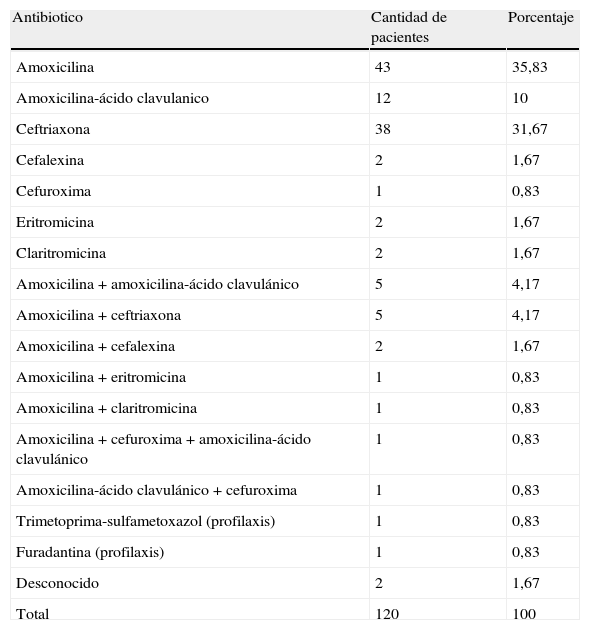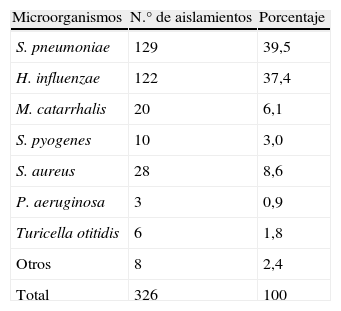La otitis media aguda (OMA) es una de las afecciones más frecuentes en la infancia y es la causa más común de prescripción de antibióticos en pediatría. El método indicado para identificar el germen responsable en OMA es la obtención de material del oído medio para cultivo mediante timpanocentesis. El objetivo de este estudio es describir la prevalencia de gérmenes causantes de OMA en pacientes eutróficos de 1 a 120 meses, que consultaron en un hospital público pediátrico.
MétodoSe incluyeron pacientes eutróficos con OMA con retención de contenido purulento en oído medio y OMA supurada con drenaje insuficiente de exudado que consultaron al Servicio de Otorrinolaringología de un hospital pediátrico desde mayo del 2009 hasta agosto del 2010.
ResultadosSe incluyeron en el estudio 324 pacientes de los cuales 180 (55,6%) eran varones. Mediana de edad: 8 meses (rango intercuartílico: 4-15 meses). OMA bilateral se registró en 109/324 (33,6%) pacientes (se obtuvieron 433 muestras para cultivo).
Al momento del diagnóstico 37% (120/324) de los niños recibían antibioticoterapia. De estos, el 59% (71/120) presentaron desarrollo bacteriano en los cultivos. La antibioticoterapia era adecuada en el 71,8% de los casos; en el 28,2% restante no se cubría el espectro del germen aislado.
ConclusiónLos microorganismos más frecuentemente aislados fueron Streptococcus pneumoniae (39,5%), Haemophilus influenzae (37,4%), Moraxella catarrhalis (6,1%) y Streptococcus pyogenes (3,0%).
Acute otitis media (AOM) is one of the most common diseases in childhood and is the most common cause of antibiotic prescriptions in children. The gold standard for identifying the pathogens causing AOM is tympanocentesis. This is only possible in the stage of AOM when exudate is retained in the middle ear. The aim of this study was to describe the prevalence of organisms causing AOM in eutrophic patients at a public paediatric hospital.
Material and methodsWe included all patients with AOM diagnosed by otomicroscopy with purulent exudate retained in middle ear and suppurative AOM with inadequate drainage consulting at the Otorhinolaryngology Department in a paediatric tertiary care centre from 2 May 2009 to 31 August 2010.
ResultsThere were 324 patients included in the study, with 180/324 (55.6%) being male. The median age was 8 months (interquartile range: 4 to 15 months). Bilateral AOM was recorded in 109/324 (33.6%) patients (433 samples for culture were obtained by tympanocentesis in 324 patients). At diagnosis, 37% (120/324) of the children had been receiving antimicrobial treatment. Of the patients who had received antibiotics, 71/120 (59.1%) had bacterial growth in middle ear fluid (MEF) cultures, with 51/71 (71.8%) being susceptible to the antibiotic they received; 20/71 (28.2%) patients were receiving an antibiotic that did not cover the spectrum of organisms isolated.
ConclusionThe pathogens most frequently isolated are Streptococcus pneumoniae (39.5%), Haemophilus influenzae (37.4%), Moraxella catarrhalis (6.1%) and Streptococcus pyogenes (3.0%).
Artículo
Comprando el artículo el PDF del mismo podrá ser descargado
Precio 19,34 €
Comprar ahora








